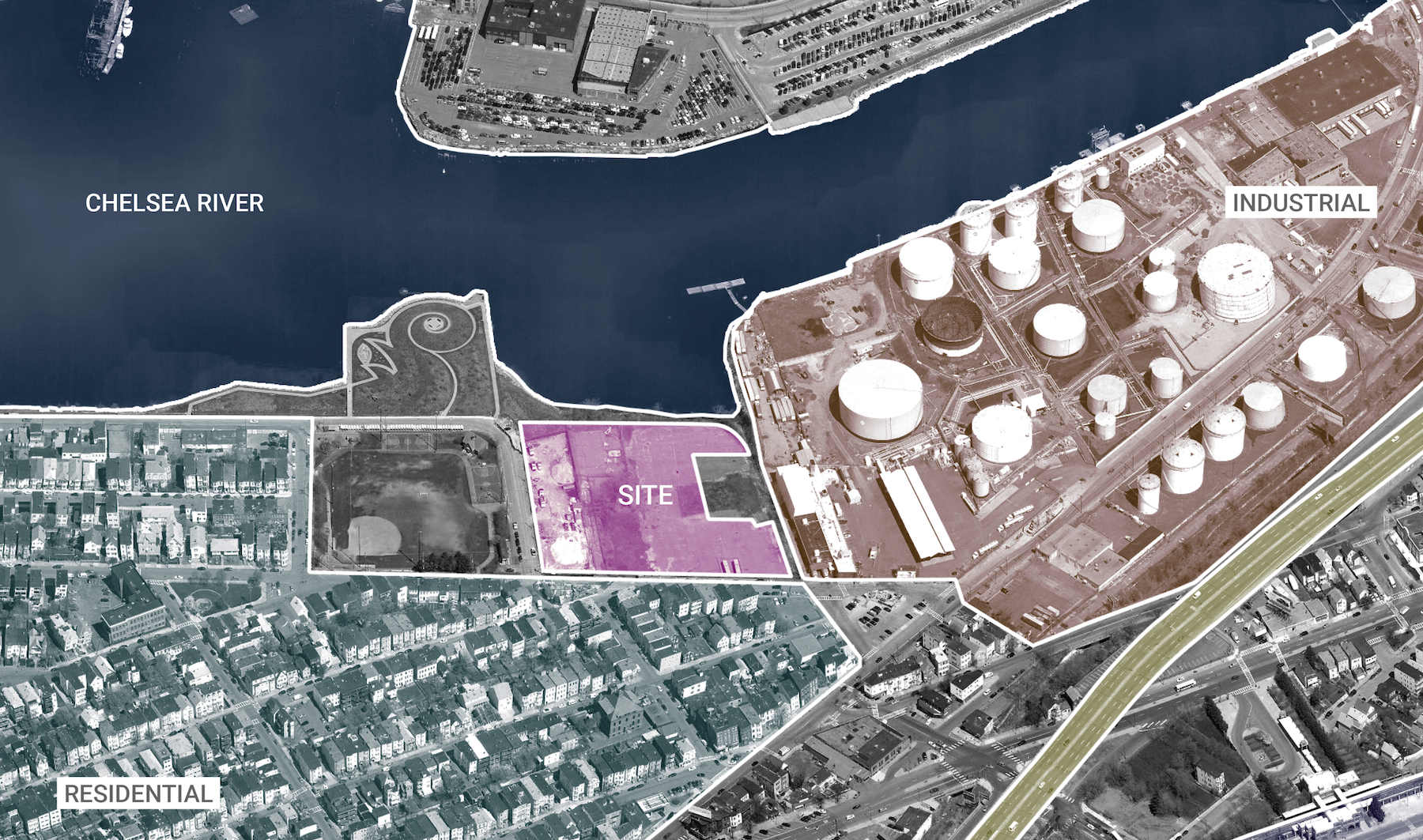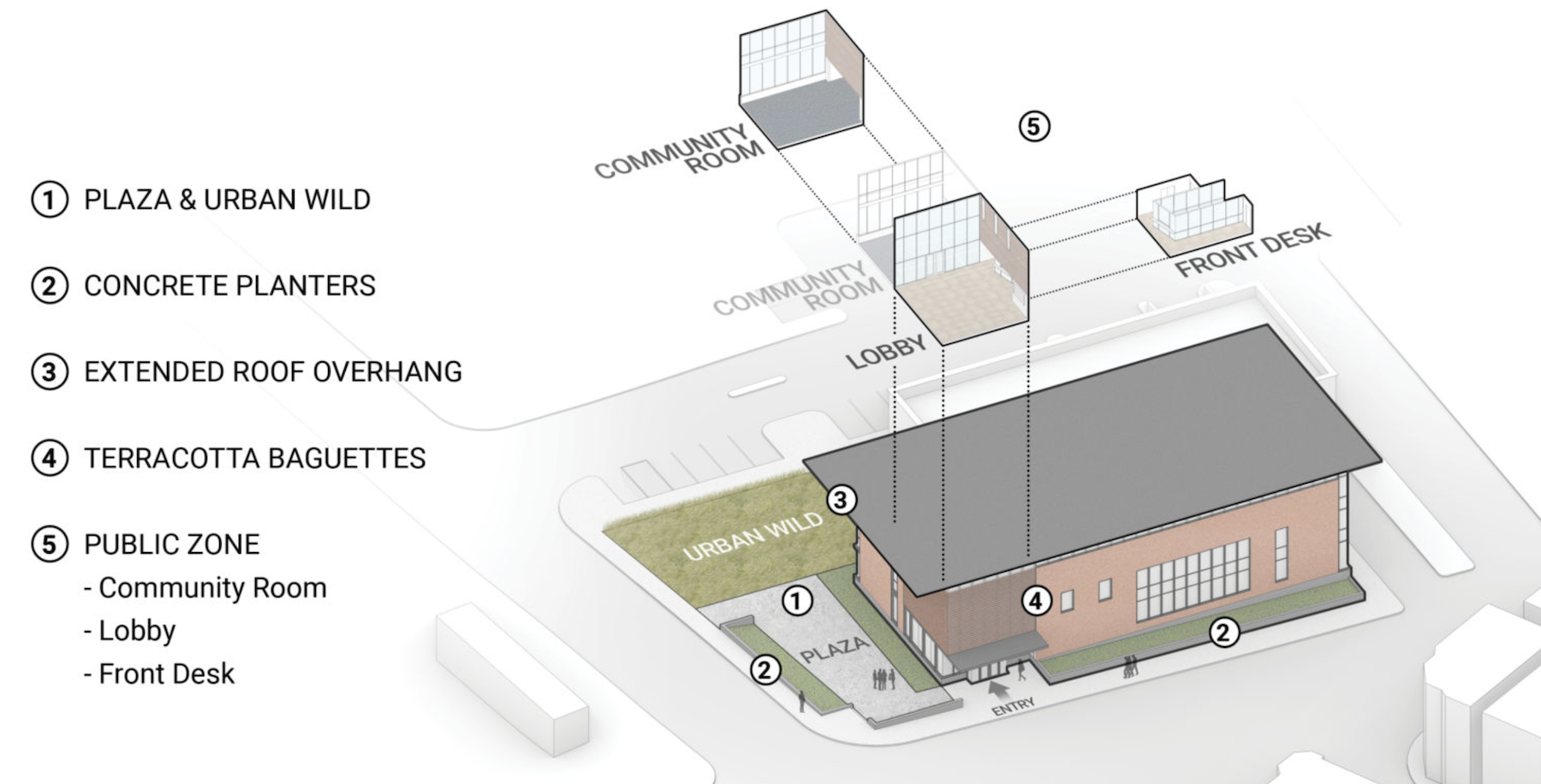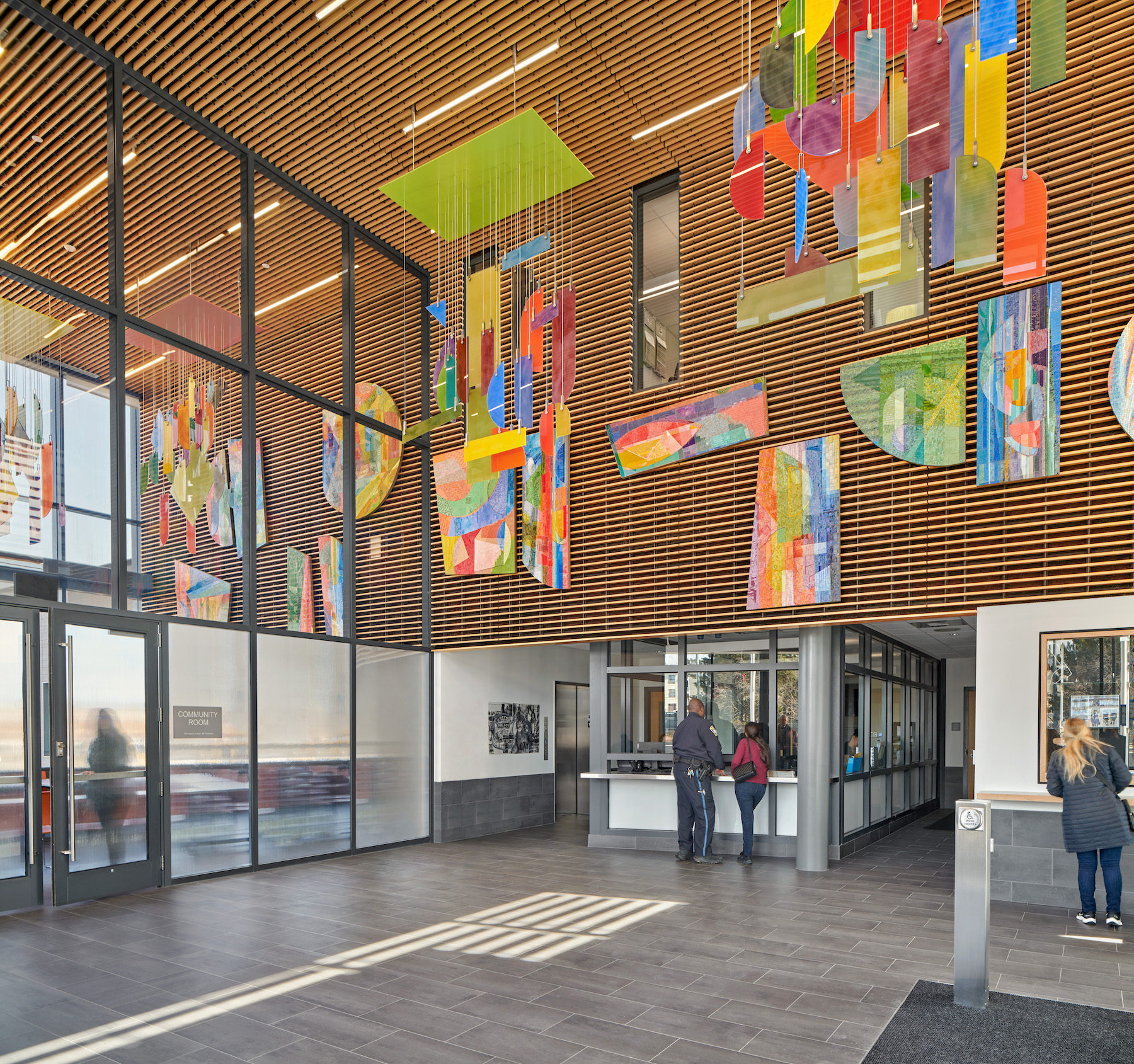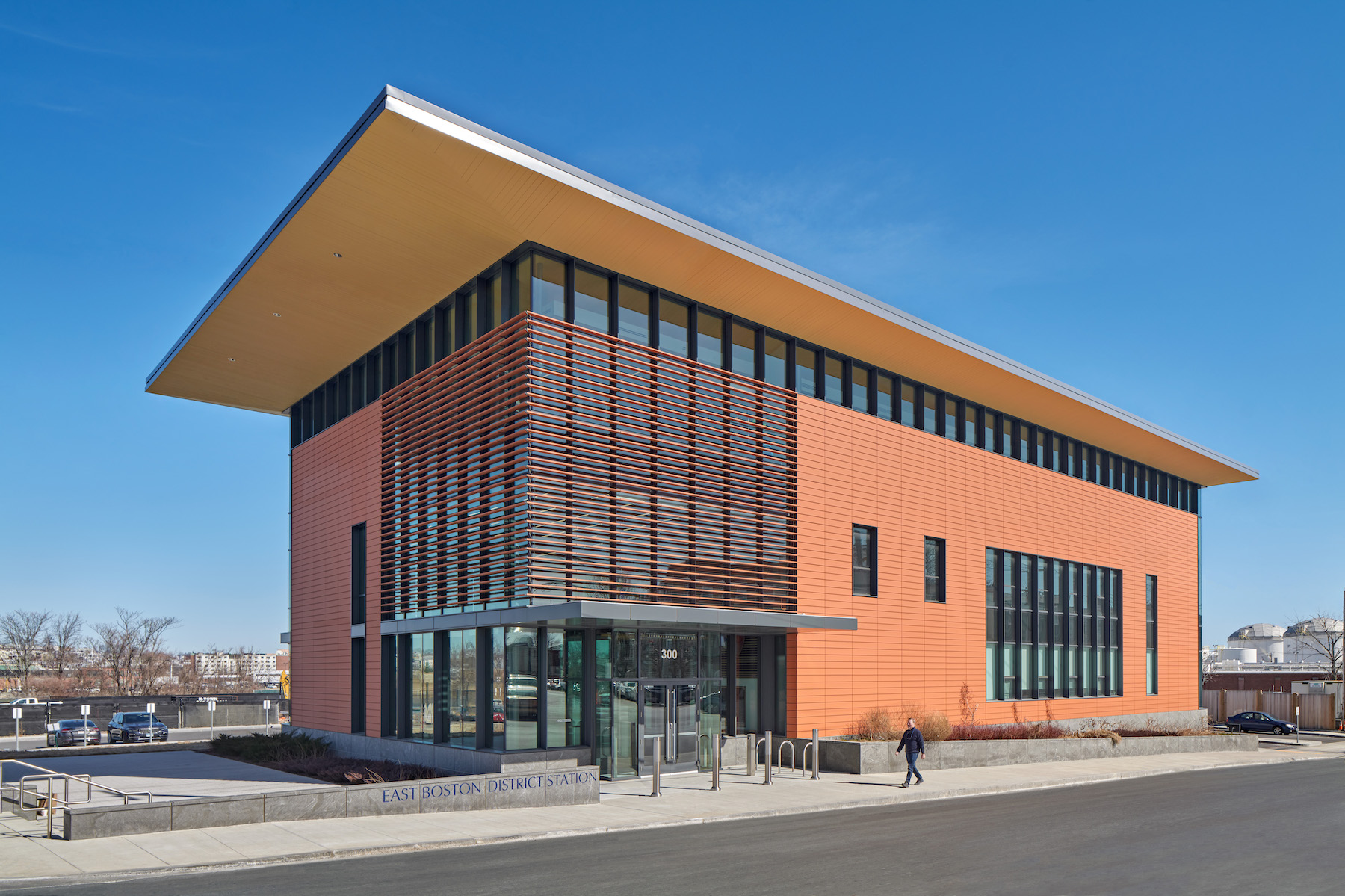A 2022 Gallup poll found that only 45 percent of surveyed American adults was confident in the police as an institution, down five percentage points from the previous year. That level of confidence dropped to 30 percent among non-white Americans polled.
Mistrust of the cops, exacerbated by high-profile incidents of law enforcement turned abusive and deadly, is not a problem with one answer, nor can appearance be a substitute for real reform. But can a building for whose design a community weighs in be part of the solution?
When the new Area 7 police station opened in East Boston, Mass., last January 1, it represented Beantown’s first new station in more than a decade, and as importantly a symbol of that city’s efforts to improve the relationship between its police force and the public at a time when community relations—in Boston as across the country—have been fraught with enmity.
Leers Weinzapfel Associates (LWA) designed the $25 million 27,500-sf East Boston District Station in collaboration with the City of Boston Public Facilities Department. The design followed several public meetings to hear the community’s opinions about the project, public safety, traffic, and accessibility, according to the boston.gov website, which reported the total cost for this project at $29.9 million.
“An investment in our municipal buildings is an investment in our City workers and our residents. This new state-of-the-art station provides the working environment our officers deserve and creates a more accessible experience for the local community,” said Boston’s Mayor Michelle Wu when the station opened.

A less threatening and efficient environment
The new station was moved from the old station's location to enhance community access, improve dispatch response times by being closer to main transport arteries, and to serve as a sustainable, resilient facility (it’s certified LEED Silver) along the Chelsea River, where the building is positioned as a kind of “mediator” between this urban neighborhood’s industrial, commercial, and residential landscapes.
According to LWA, the station’s granite and terracotta structure responds to the scale of surrounding residential and public buildings. A corner of the station features a glass entry, lobby, and community room that coalesce to form a sun-filled public zone. Within the building, occupied spaces maximize daylight and views. Front supervisory desks have views of public areas and connections to police operations and detention zones. (The main building houses police operations, detective offices, a guard room, and lockers. Secure detention areas are in the rear of the building.)
“We saw this project as an opportunity to architecturally address the hot-button issue of community policing elevating the spaces, and therefore the experiences, where the police and those they serve come together,” said Josiah Stevenson, LWA’s Principal-in-Charge, in a prepared statement.


Stevenson elaborated that the Building Team—which included the structural engineering firm LeMessurier and general contractor J&J Contractors—created a double-height interior and used “warm” materials. The station’s site makes the most of views of the nearby creek and public plaza. A series of glass sculptures, dubbed “Unus Mundus” (”One World”) by its artist Monika Bravo, further accentuates a welcoming environment.
The new facility includes stormwater management and energy efficient systems.

Right after the police station opened, Mayor Wu announced the allocation of $25 million for a new community center in Boston’s North End neighborhood. Last year, Wu announced a $2 billion plan to make the city’s public schools greener through new construction and renovation.
Related Stories
| Mar 26, 2014
Callison launches sustainable design tool with 84 proven strategies
Hybrid ventilation, nighttime cooling, and fuel cell technology are among the dozens of sustainable design techniques profiled by Callison on its new website, Matrix.Callison.com.
| Mar 20, 2014
Common EIFS failures, and how to prevent them
Poor workmanship, impact damage, building movement, and incompatible or unsound substrate are among the major culprits of EIFS problems.
| Mar 17, 2014
Rem Koolhaas explains China's plans for its 'ghost cities'
China's goal, according to Koolhaas, is to de-incentivize migration into already overcrowded cities.
| Mar 12, 2014
14 new ideas for doors and door hardware
From a high-tech classroom lockdown system to an impact-resistant wide-stile door line, BD+C editors present a collection of door and door hardware innovations.
| Feb 27, 2014
Open or private offices? It depends on the business plan
Open layouts are grabbing headlines as a hallmark of the new workplace—think the Google campus or Facebook's headquarters. And for smaller-scale operations, open designs are often lauded for being less expensive than private office plans. But does that mean all offices should have an open layout?
| Feb 21, 2014
Calatrava ordered to pay millions for 'shortcomings in his work' on conference center project
Famed architect Santiago Calatrava must pay 2.9 million euros due to faulty design work on the Palacio de Congresos project in Oviedo, Spain.
| Feb 14, 2014
Crowdsourced Placemaking: How people will help shape architecture
The rise of mobile devices and social media, coupled with the use of advanced survey tools and interactive mapping apps, has created a powerful conduit through which Building Teams can capture real-time data on the public. For the first time, the masses can have a real say in how the built environment around them is formed—that is, if Building Teams are willing to listen.
| Feb 12, 2014
First Look: Futuristic Silicon Valley campus designed to draw tech startups
The curved campus will consist of four different buildings, one exclusively for amenities like a coffee bar, bike shop, and bank.
| Feb 6, 2014
End of the open workplace?
If you’ve been following news about workplace design in the popular media, you might believe that the open workplace has run its course. While there’s no shortage of bad open-plan workplaces, there are two big flaws with the now common claim that openness is bad.
| Jan 30, 2014
The evolving workplace: One designer's inspiration board
"Open office" has been a major buzzword for decades, and like any buzzword, some of the novelty has worn off. I don't believe we will abandon the open office, but I do think we need to focus on providing a dynamic mix of open and closed spaces.

















